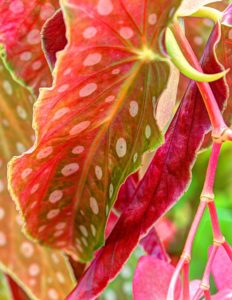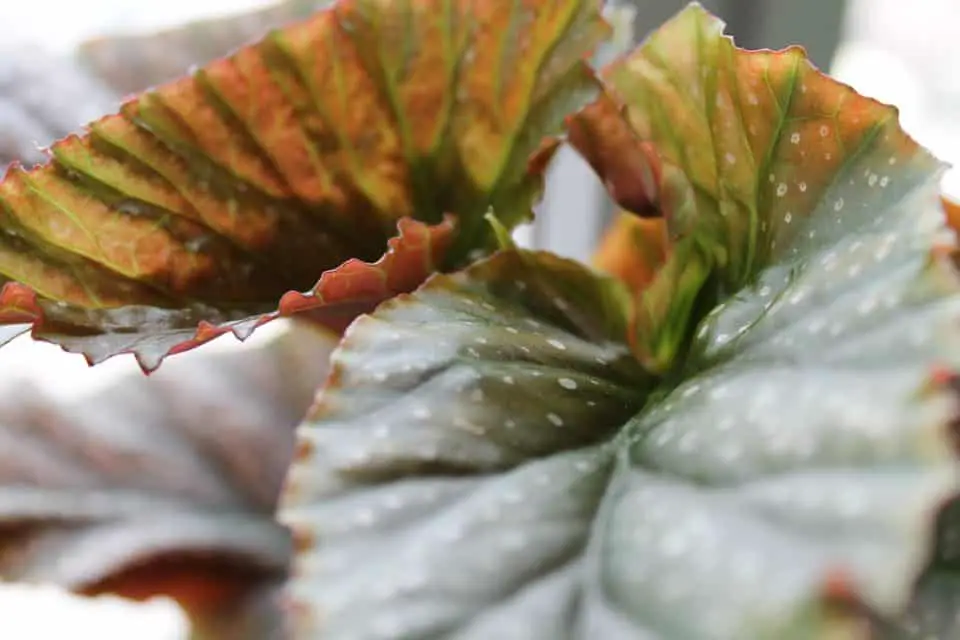Some links in the post are affiliate links and I get a commission from purchases made through some links found in the post.
Of all the begonias I have had – and there have been many of them – the most attractive one to me has been the angel wing begonia.
I find the leaves and their colours to be simply amazing! Not to mention the beautiful flowers which can range from white to orange, pink, and red.
Begonias are not that difficult to grow but I’ve found that there are some things that keep them happy and other things that leave you with a sad looking plant.
These plants are perennial shrubs which can be planted all year round. They like moist but well drained soil or potting mix, and they are perfectly suited for growing indoors.
The most common reasons for your angel wing begonia to be drooping is overwatering and underwatering.
The other reasons your angel wing begonia could be drooping is due to pest problems, insufficient light, transplant shock, pot size issues and temperature stress.
Why is my Angel Wing Begonia Drooping?
There are basically only two main reasons why your angel wing begonia is drooping, namely:
- Underwatering
- Overwatering
Once their soil or potting mix dries out the begonia will start to droop.
Conversely if they are overwatered and their roots are left in excessively wet soil they will develop root rot and also start to droop.
There are other reasons to wilt such as transplant shock, excessive high temperature, and disease. The most likely is to be due to too much or too little water when those lovely leaves start to droop.
Underwatering
If you have let the soil dry out you will notice in a very short time that your plant is drooping and wilting.
Dig down into the soil with your fingers and see how dry it is. If the top two or more inches are dry then your plant needs water.
Your begonia needs more than a few drops of water. It needs a good soak until the excess water runs out of the drainage holes at the base of the pot.
Do this slowly to give the soil time to absorb what it needs. Within a day or so you will see that your plant has miraculously come back to life!
Overwatering
This is one thing that can indeed kill your begonia and unfortunately it can happen very quickly, so it is best avoided.
Soil which is constantly sodden will be a breeding ground for infection and the roots will most certainly rot.
There are some tell-tale signs that your plant is overwatered such as leaves which turn yellow, leaves which droop and feel soggy, and the stems breaking easily.
It is easy to overwater your begonia if the plant is placed in an area with low light because the soil will stay wet for longer.
You should also make sure that the pot has adequate drainage holes underneath, and the drip tray if you use one, is emptied regularly.
The soil should be of the type that drains well and is not like clay which will hold the water.
If you need help watering your plant, try using this automatic drip irrigation kit.
Why is my Angel Wing Begonia Losing Leaves?
Because begonias are susceptible to root rot you will find that they let you know soon enough that they are not happy. They will do this by dropping their leaves
If your plant is waterlogged or overwatered it will droop and then drop its leaves.
Because begonias are classed as succulents you will find, if you look closely, that the stems are mostly water so being too wet simply encourages fungus and mold. Eventually the leaves will rot and drop off.
If you are enjoying this article, check out our article on why are my croton leaves drooping.
Why are my Angel Wing Begonia Leaves Curling?
 The main reasons for angel wing begonia leaves curling are:
The main reasons for angel wing begonia leaves curling are:
- Incorrect lighting
- Overwatering
- Underwatering
- Pests
- Diseases
Apart from being affected by diseases, curling leaves are easily rectified. Often, all you need to do is to check the lighting conditions and adjust the watering routine.
If your plant is struggling due to light, trying using this to help regulate the lighting.
Pests
Aphids are the biggest threat to your begonia. They feed on the plant’s leaves, stealing essential nutrients from it.
After that they leave a substance on the plant which encourages mold to grow.
You will see tell-tale signs of aphids, in fact they are visible to the naked eye. Washing up liquid mixed with water can be sprayed on to remove them.
If the infestation is large you may need to buy an insecticidal spray from your garden centre.
The Begonia Biller – Fungal Disease
Stem and root rot in begonias is the main culprit here. This is a fungal condition which affects them.
It is spread through moisture such as damp soil and cold weather. Which is why they are so often grown indoors in a warmer climate.
You will know that your begonia has been infected with a fungal disease if the leaves start to curl and the stem starts to droop to the point of collapsing.
For any lover of begonias this is a hard position to find yourself in because the plant does not recover from it. Your best action is to get rid of it and start again with a healthy plant.
Other Common Angel Wing Begonia Problems
Like most houseplants angel wing begonias have some common issues which are more of a nuisance than a danger.
- Powdery mildew
- Mealybugs
- Whiteflies
Powdery Mildew
You will recognise this right away as it is exactly what it says. It’s a grey or white powder which forms on the leaves, stems, and flowers.
It can be difficult to treat but a commercial fungicide will take care of it. You can prevent it by not having too many plants too close to each other so that air circulation is restricted
Mealybugs
If you look on the underside of the leaves you may see an area which looks like a piece of fine cotton.
Normally pesticides are no help here so you will need to buy some insecticidal soap spray and apply it often to be effective.
Whiteflies
These are normally large enough to see with the naked eye, they leave a waxy area on the leaves.
Unfortunately, you cannot control them with pesticides so you may want to use and insecticidal soap spray to keep them away. Make sure that you drench the entire plant.
Final Thoughts
As with any plants you bring into your house, you should be careful where you place them. You should also educate yourself as to which are harmful to children and animals, and which are safe.
With angel wing begonias all parts of the plants are moderately toxic so this should dictate where you place your plant.
The roots of this plant are particularly toxic so make sure to keep your cat away from them.
This plant is easy to care for and with a little bit of knowledge about what it likes there will be no reason for you to ask why your angel wing begonia is drooping.
Before you go, here are some more related articles I encourage you to read below to help solve more of your gardening issues:
How to fix your oxalis (purple shamrock) problems
How to Stop Your Dieffenbachia Leaves from Drooping
Why are your Bird of Paradise Leaves Drooping


